An Interwoven Psychological Syndrome of Job Burnout and Work Engagement in Construction Project Management Professionals Due to Work–Family Imbalance
Abstract
1. Introduction
2. Literature Review
2.1. Research on Work–Family Conflict and Work–Family Enrichment
2.2. Research on Job Burnout and Work Engagement
2.3. Research on FSSB
3. Theoretical Analyses and Hypotheses
3.1. Theoretical Base
3.2. Relationship between Work–Family Conflict, Work–Family Enrichment, Job Burnout, and Work Engagement
3.3. Relationship between FSSB and Each Variable
3.4. Development of the Hypothetical Model
4. Materials and Methods
4.1. Measures
4.2. Questionnaire Survey
5. Results
5.1. Statistics
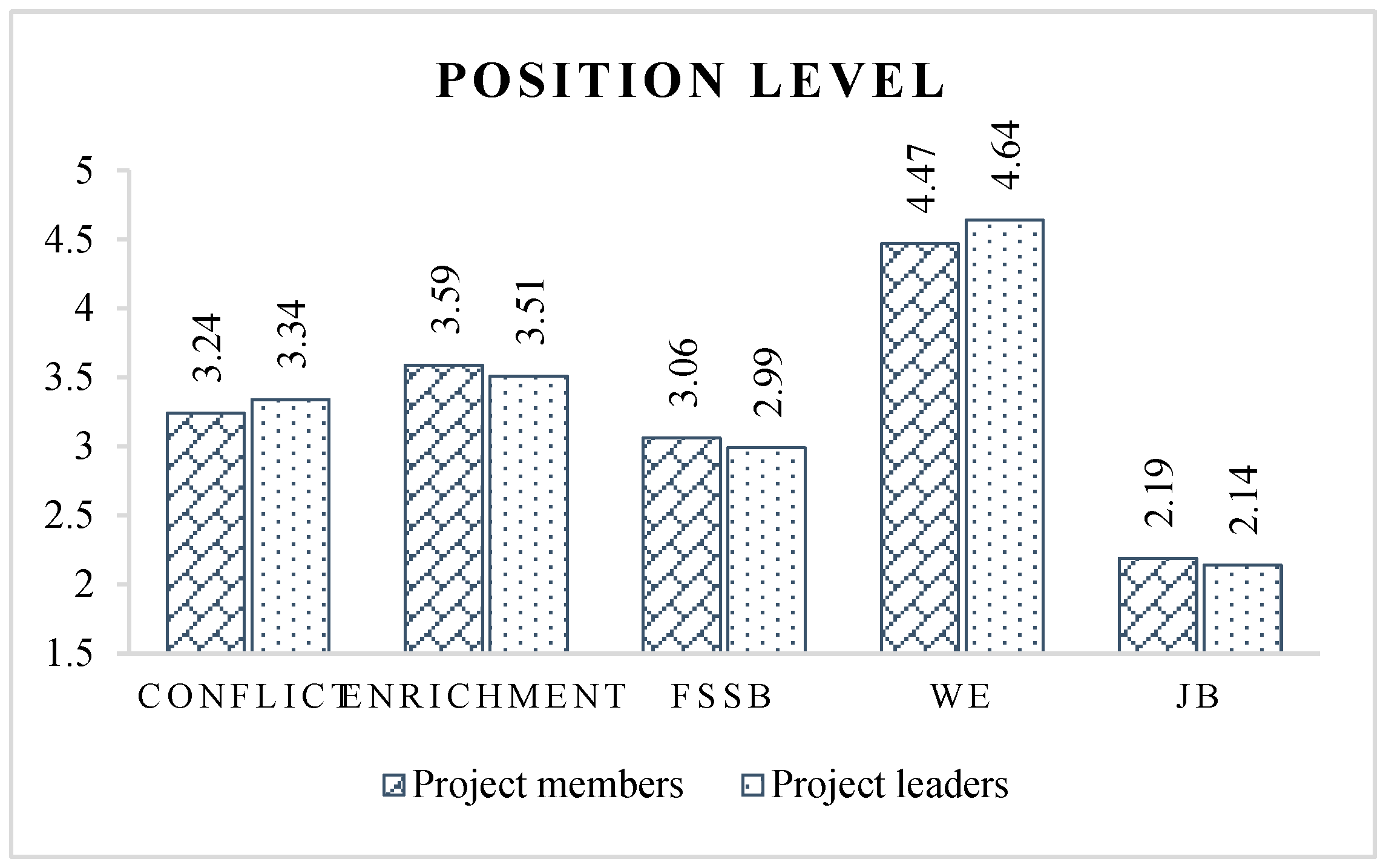
5.2. Reliability and Validity
5.3. Structural Equation Model
6. Discussion
6.1. The Relationships among Work–Family Conflict, Work–Family Enrichment, Job Burnout, and Work Engagement
6.2. The Relationship between FSSB and Each Variable
7. Conclusions
Author Contributions
Funding
Institutional Review Board Statement
Informed Consent Statement
Data Availability Statement
Conflicts of Interest
References
- Yang, F.; Li, X.; Song, Z.; Li, Y.; Zhu, Y. Job burnout of construction project managers: Considering the role of organizational justice. J. Constr. Eng. Manag. 2018, 144, 04018103. [Google Scholar] [CrossRef]
- Yang, F.; Li, X.; Zhu, Y.; Li, Y.; Wu, C. Job burnout of construction project managers in China: A cross-sectional analysis. Int. J. Proj. Manag. 2017, 35, 1272–1287. [Google Scholar] [CrossRef]
- Holden, S.; Sunindijo, R.Y. Technology, long work hours, and stress worsen work-life balance in the construction industry. Int. J. Integr. Eng. 2018, 10, 13–18. [Google Scholar] [CrossRef]
- Campbell, F. Occupational Stress in the Construction Industry; Chartered Institute of Building: Berkshire, UK, 2006. [Google Scholar]
- Pinto, J.K.; Patanakul, P.; Pinto, M.B. Project personnel, job demands, and workplace burnout: The differential effects of job title and project type. IEEE Trans. Eng. Manag. 2016, 63, 91–100. [Google Scholar] [CrossRef]
- Yip, B.; Rowlinson, S. Job burnout among construction engineers working within consulting and contracting organizations. J. Manag. Eng. 2009, 25, 122–130. [Google Scholar] [CrossRef]
- Xie, Q.; Xia, N.; Yang, G. Do family affairs matter? Work–family conflict and safety behavior of construction workers. J. Manag. Eng. 2022, 38, 04021074. [Google Scholar] [CrossRef]
- Schaufeli, W.B.; Salanova, M.; González-Romá, V.; Bakker, A.B. The measurement of engagement and burnout: A two sample confirmatory factor analytic approach. J. Happiness Stud. 2002, 3, 71–92. [Google Scholar] [CrossRef]
- Seligman, M.E.P.; Csikszentmihalyi, M. Positive psychology: An introduction. Am. Psychol. 2000, 55, 5–14. [Google Scholar] [CrossRef]
- Gable, S.L.; Haidt, J. What (and why) is positive psychology? Rev. Gen. Psychol. 2005, 9, 103–110. [Google Scholar] [CrossRef]
- Peterson, C. Positive psychology. Reclaiming Child. Youth 2009, 18, 3–7. [Google Scholar]
- Russell, J.A.; Carroll, J.M. On the bipolarity of positive and negative affect. Psychol. Bull. 1999, 125, 3–30. [Google Scholar] [CrossRef]
- Schaufeli, W.B.; Bakker, A.B. Job demands, job resources, and their relationship with burnout and engagement: A multi-sample study. J. Organ. Behav. 2004, 25, 293–315. [Google Scholar] [CrossRef]
- Demerouti, E.; Mostert, K.; Bakker, A.B. Burnout and work engagement: A thorough investigation of the independency of both constructs. J. Occup. Health Psychol. 2010, 15, 209–222. [Google Scholar] [CrossRef]
- George, J.M. Dual tuning. Organ. Psychol. Rev. 2011, 1, 147–164. [Google Scholar] [CrossRef]
- Dulk, L.D.; de Ruijter, J. Managing work-life policies: Disruption versus dependency arguments. Explaining managerial attitudes towards employee utilization of work-life policies. Int. J. Hum. Resour. Manag. 2008, 19, 1222–1236. [Google Scholar] [CrossRef]
- McCarthy, A.; Darcy, C.; Grady, G. Work-life balance policy and practice: Understanding line manager attitudes and behaviors. Hum. Resour. Manag. Rev. 2010, 20, 158–167. [Google Scholar] [CrossRef]
- Straub, C. Antecedents and organizational consequences of family supportive supervisor behavior: A multilevel conceptual framework for research. Hum. Resour. Manag. Rev. 2011, 22, 15–26. [Google Scholar] [CrossRef]
- Hammer, L.B.; Kossek, E.E.; Zimmerman, K.; Daniels, R. Clarifying the construct of family-supportive supervisory behaviors (FSSB): A multilevel perspective. In Exploring the Work and Non-Work Interface; Research in Occupational Stress and Well-Being; Perrewe, P.L., Ganster, D.C., Eds.; Emerald Publishing Limited: Bingley, UK, 2007; Volume 6, pp. 165–204. [Google Scholar] [CrossRef]
- Crain, T.L.; Stevens, S.C. Family-supportive supervisor behaviors: A review and recommendations for research and practice. J. Organ. Behav. 2018, 39, 869–888. [Google Scholar] [CrossRef]
- Leung, M.; Chan, Y.S.I.; Dongyu, C. Structural linear relationships between job stress, burnout, physiological stress, and performance of construction project managers. Eng. Constr. Arch. Manag. 2011, 18, 312–328. [Google Scholar] [CrossRef]
- Chan, I.Y.S.; Leung, M.-Y.; Liang, Q. The roles of motivation and coping behaviours in managing stress: Qualitative interview study of Hong Kong expatriate construction professionals in mainland China. Int. J. Environ. Res. Public Health 2018, 15, 561. [Google Scholar] [CrossRef]
- Odle-Dusseau, H.N.; Britt, T.W.; Greene-Shortridge, T.M. Organizational work–family resources as predictors of job performance and attitudes: The process of work–family conflict and enrichment. J. Occup. Health Psychol. 2012, 17, 28–40. [Google Scholar] [CrossRef]
- Wang, X.Y.; Li, X.D.; Yang, F.; Zhang, Z.H. Review on work-family relationships of construction professionals. J. Eng. Manag. 2019, 33, 1–6. (In Chinese) [Google Scholar] [CrossRef]
- Greenhaus, J.H.; Beutell, N.J. Sources of conflict between work and family roles. Acad. Manag. Rev. 1985, 10, 76. [Google Scholar] [CrossRef]
- Carlson, D.S. Personality and role variables as predictors of three forms of work–family conflict. J. Vocat. Behav. 1999, 55, 236–253. [Google Scholar] [CrossRef]
- Greenhaus, J.H.; Powell, G.N. When work and family are allies: A theory of work-family enrichment. Acad. Manag. Rev. 2006, 31, 72–92. [Google Scholar] [CrossRef]
- Lingard, H.; Lin, J. Managing motherhood in the Australian construction industry: Work-family Balance, Parental Leave and Part-time Work. Constr. Econ. Build. 2003, 3, 15–24. [Google Scholar] [CrossRef]
- Francis, V.; Lingard, H.; Prosser, A.; Turner, M. Work-family and construction: Public and private sector differences. J. Manag. Eng. 2013, 29, 392–399. [Google Scholar] [CrossRef]
- Turner, M.; Lingard, H.; Francis, V. Work-life balance: An exploratory study of supports and barriers in a construction project. Int. J. Manag. Proj. Bus. 2009, 2, 94–111. [Google Scholar] [CrossRef]
- Davis, H.; Francis, V. ICT in construction: Can it reduce work-family conflict by decreasing workloads? In Proceedings of the 28th Australian Conference on Computer-Human Interaction, Launceston, Australia, 29 November–2 December 2016; Association for Computing Machinery: New York, NY, USA, 2016; pp. 447–451. [Google Scholar]
- Lingard, H.C.; Francis, V.; Turner, M. Work–family enrichment in the Australian construction industry: Implications for job design. Constr. Manag. Econ. 2010, 28, 467–480. [Google Scholar] [CrossRef]
- Maslach, C.; Schaufeli, W.B.; Leiter, M.P. Job Burnout. Annu. Rev. Psychol. 2001, 52, 397–422. [Google Scholar] [CrossRef]
- Li, X.; Fei, Y.; Rizzuto, T.E.; Yang, F. What are the occupational hazards of construction project managers: A data mining analysis in China. Saf. Sci. 2020, 134, 105088. [Google Scholar] [CrossRef]
- Hammer, L.B.; Kossek, E.E.; Yragui, N.L.; Bodner, T.E.; Hanson, G.C. Development and validation of a multidimensional measure of family supportive supervisor behaviors (FSSB). J. Manag. 2008, 35, 837–856. [Google Scholar] [CrossRef]
- Hammer, L.B.; Kossek, E.E.; Anger, W.K.; Bodner, T.; Zimmerman, K.L. Clarifying work–family intervention processes: The roles of work–family conflict and family-supportive supervisor behaviors. J. Appl. Psychol. 2011, 96, 134–150. [Google Scholar] [CrossRef]
- Karasek, R.A. Job demands, job decision latitude, and mental strain: Implications for job redesign. Adm. Sci. Q. 1979, 24, 285–308. [Google Scholar] [CrossRef]
- Johnson, J.V.; Hall, E.M. Job strain, work place social support, and cardiovascular disease: A cross-sectional study of a random sample of the Swedish working population. Am. J. Public Health 1988, 78, 1336–1342. [Google Scholar] [CrossRef]
- Siegrist, J. Adverse health effects of high-effort/low-reward conditions. J. Occup. Health Psychol. 1996, 1, 27–41. [Google Scholar] [CrossRef]
- Demerouti, E.; Bakker, A.B.; Nachreiner, F.; Schaufeli, W.B. The job demands-resources model of burnout. J. Appl. Psychol. 2001, 86, 499–512. [Google Scholar] [CrossRef]
- Pinto, J.K.; Dawood, S.; Pinto, M.B. Project management and burnout: Implications of the Demand–Control–Support model on project-based work. Int. J. Proj. Manag. 2014, 32, 578–589. [Google Scholar] [CrossRef]
- Bakker, A.B.; Demerouti, E.; Verbeke, W. Using the job demands-resources model to predict burnout and performance. Hum. Resour. Manag. 2004, 43, 83–104. [Google Scholar] [CrossRef]
- Schaufeli, W.B.; Bakker, A.B.; Van Rhenen, W. How changes in job demands and resources predict burnout, work engagement, and sickness absenteeism. J. Organ. Behav. 2009, 30, 893–917. [Google Scholar] [CrossRef]
- Bakker, A.B.; Geurts, S.A.E. Toward a dual-process model of work-home interference. Work Occup. 2004, 31, 345–366. [Google Scholar] [CrossRef]
- Purwayoga, P.V.S.; Dharmanegara, I.B.A.; Yasa, P.N.S. Mediating role of work engagement and emotional exhaustion in the effect of work-family conflict on female workers’ turnover intention. Int. J. Acad. Res. Bus. Soc. Sci. 2019, 9, 176–190. [Google Scholar] [CrossRef]
- Fiksenbaum, L.M. Supportive work–family environments: Implications for work–family conflict and well-being. Int. J. Hum. Resour. Manag. 2013, 25, 653–672. [Google Scholar] [CrossRef]
- Mansour, S.; Tremblay, D.-G. Work–family conflict/family–work conflict, job stress, burnout and intention to leave in the hotel industry in Quebec (Canada): Moderating role of need for family friendly practices as “resource passageways”. Int. J. Hum. Resour. Manag. 2016, 29, 2399–2430. [Google Scholar] [CrossRef]
- Laeeque, S.H. Role of work-family conflict in job burnout: Support from the banking sector of Pakistan. Int. Lett. Soc. Humanist. Sci. 2014, 40, 2300–2697. [Google Scholar] [CrossRef]
- Bruck, C.S.; Allen, T.; Spector, P.E. The relation between work–family conflict and job satisfaction: A finer-grained analysis. J. Vocat. Behav. 2002, 60, 336–353. [Google Scholar] [CrossRef]
- Shockley, K.M.; Singla, N. Reconsidering work—Family interactions and satisfaction: A meta-analysis. J. Manag. 2011, 37, 861–886. [Google Scholar] [CrossRef]
- Lingard, H. The impact of individual and job characteristics on ‘burnout’ among civil engineers in Australia and the implications for employee turnover. Constr. Manag. Econ. 2003, 21, 69–80. [Google Scholar] [CrossRef]
- Qing, G.; Zhou, E.; Guoxia, Q.; Erhua, Z. Bidirectional work–family enrichment mediates the relationship between family-supportive supervisor behaviors and work engagement. Soc. Behav. Pers. Int. J. 2017, 45, 299–308. [Google Scholar] [CrossRef]
- Wayne, J.H.; Musisca, N.; Fleeson, W. Considering the role of personality in the work–family experience: Relationships of the big five to work–family conflict and facilitation. J. Vocat. Behav. 2004, 64, 108–130. [Google Scholar] [CrossRef]
- Siu, O.L.; Bakker, A.B.; Brough, P.; Lu, C.-Q.; Wang, H.; Kalliath, T.; O’Driscoll, M.; Lu, J.; Timms, C. A three-wave study of antecedents of work-family enrichment: The roles of social resources and affect. Stress Health 2015, 31, 306–314. [Google Scholar] [CrossRef]
- Cinamon, R.G.; Rich, Y. Work family relations: Antecedents and outcomes. J. Career Assess. 2009, 18, 59–70. [Google Scholar] [CrossRef]
- Innstrand, S.T.; Langballe, E.M.; Espnes, G.A.; Falkum, E.; Aasland, O.G. Positive and negative work–family interaction and burnout: A longitudinal study of reciprocal relations. Work Stress 2008, 22, 1–15. [Google Scholar] [CrossRef]
- Robinson, L.D.; Magee, C.; Caputi, P. Burnout and the work-family interface. Career Dev. Int. 2016, 21, 31–44. [Google Scholar] [CrossRef]
- Ollier-Malaterre, A.; Haar, J.M.; Sunyer, A.; Russo, M. Supportive organizations, work–family enrichment, and job burnout in low and high humane orientation cultures. Appl. Psychol. 2019, 69, 1215–1247. [Google Scholar] [CrossRef]
- Xiaobing, Z.; Shiyun, Z. The effects of work-family enrichment on knowledge workers’ job burnout and mental health. In Proceedings of the IEEE, Harbin, China, 8–11 January 2011; pp. 299–302. [Google Scholar]
- Mostert, K. Job characteristics, work–home interference and burnout: Testing a structural model in the South African context. Int. J. Hum. Resour. Manag. 2011, 22, 1036–1053. [Google Scholar] [CrossRef]
- Kossek, E.E.; Pichler, S.; Bodner, T.; Hammer, L.B. Workplace social support and work-family conflict: A meta-analysis clarifying the influence of general and work-family-specific supervisor and organizational support. Pers. Psychol. 2011, 64, 289–313. [Google Scholar] [CrossRef]
- Crain, T.L.; Hammer, L.B.; Bodner, T.; Kossek, E.E.; Moen, P.; Lilienthal, R.; Buxton, O.M. Work–family conflict, family-supportive supervisor behaviors (FSSB), and sleep outcomes. J. Occup. Health Psychol. 2014, 19, 155–167. [Google Scholar] [CrossRef]
- Kailasapathy, P.; Jayakody, J.A.S.K. Does leadership matter? Leadership styles, family supportive supervisor behaviour and work interference with family conflict. Int. J. Hum. Resour. Manag. 2016, 29, 3033–3067. [Google Scholar] [CrossRef]
- Chan, X.W.; Kalliath, P.; Chan, C.; Kalliath, T. How does family support facilitate job satisfaction? Investigating the chain mediating effects of work–family enrichment and job-related well-being. Stress Health 2019, 36, 97–104. [Google Scholar] [CrossRef]
- Bond, F.W.; Bunce, D. The role of acceptance and job control in mental health, job satisfaction, and work performance. J. Appl. Psychol. 2003, 88, 1057–1067. [Google Scholar] [CrossRef]
- Bakker, A.B.; Demerouti, E. The Job Demands-Resources model: State of the art. J. Manag. Psychol. 2007, 22, 309–328. [Google Scholar] [CrossRef]
- Matthews, R.A.; Mills, M.J.; Trout, R.C.; English, L. Family-supportive supervisor behaviors, work engagement, and subjective well-being: A contextually dependent mediated process. J. Occup. Health Psychol. 2014, 19, 168–181. [Google Scholar] [CrossRef]
- Shi, Y.; Xie, J.; Zhou, Z.E.; Tang, H.; Ma, H. Family supportive supervisor behaviors and work engagement: A social information processing perspective. Curr. Psychol. 2019, 41, 347–359. [Google Scholar] [CrossRef]
- Rofcanin, Y.; Heras, M.L.; Escribano, P.I.; Stanko, T. FSSBs and elderly care: Exploring the role of organizational context on employees’ overall health and work–family balance satisfaction. J. Bus. Psychol. 2019, 35, 403–419. [Google Scholar] [CrossRef]
- Yragui, N.L.; Demsky, C.A.; Hammer, L.B.; Van Dyck, S.; Neradilek, M.B. Linking workplace aggression to employee well-being and work: The moderating role of family-supportive supervisor behaviors (FSSB). J. Bus. Psychol. 2016, 32, 179–196. [Google Scholar] [CrossRef]
- Carlson, D.S.; Kacmarb, K.M.; Williams, L.J. Construction and initial validation of a multidimensional measure of work–family conflict. J. Vocat. Behav. 2000, 56, 249–276. [Google Scholar] [CrossRef]
- Carlson, D.S.; Kacmar, K.M.; Wayne, J.H.; Grzywacz, J.G. Measuring the positive side of the work–family interface: Development and validation of a work–family enrichment scale. J. Vocat. Behav. 2006, 68, 131–164. [Google Scholar] [CrossRef]
- Maslach, C.; Jackson, S.; Leiter, M. The Maslach Burnout Inventory Manual; Consulting Psychologists Press: Palo Alto, CA, USA, 1997; Volume 3, pp. 191–218. [Google Scholar]
- Schaufeli, W.B.; Bakker, A.B.; Salanova, M. The measurement of work engagement with a short questionnaire: A cross-national study. Educ. Psychol. Meas. 2006, 66, 701–716. [Google Scholar] [CrossRef]
- Lingard, H.; Sublet, A. The impact of job and organizational demands on marital or relationship satisfaction and conflict among Australian civil engineers. Constr. Manag. Econ. 2002, 20, 507–521. [Google Scholar] [CrossRef]
- Loughlin, C.; Barling, J. Young workers’ work values, attitudes, and behaviours. J. Occup. Organ. Psychol. 2001, 74, 543–558. [Google Scholar] [CrossRef]
- Mohammadpoorasl, A.; Maleki, A.; Sahebihagh, M.H. Prevalence of professional burnout and its related factors among nurses in Tabriz in 2010. Iran. J. Nurs. Midwifery Res. 2012, 17, 524–529. [Google Scholar] [PubMed]
- Browne, M.W.; Cudeck, R. Alternative ways of assessing model fit. Sociol. Methods Res. 1992, 21, 230–258. [Google Scholar] [CrossRef]
- Fornell, C.; Larcker, D.F. Structural equation models with unobservable variables and measurement error: Algebra and statistics. J. Mark. Res. 1981, 18, 382–388. [Google Scholar] [CrossRef]
- Davis, K.D.; Lawson, K.M.; Almeida, D.M.; Kelly, E.L.; King, R.B.; Hammer, L.; Casper, L.M.; Okechukwu, C.A.; Hanson, G.; McHale, S.M. Parents’ daily time with their children: A workplace intervention. Pediatrics 2015, 135, 875–882. [Google Scholar] [CrossRef]
- Yu, A.; Pichler, S.; Russo, M.; Hammer, L. Family-supportive supervisor behaviors (FSSB) and work-family conflict: The role of stereotype content, supervisor gender, and gender role beliefs. J. Occup. Organ. Psychol. 2021, 95, 275–304. [Google Scholar] [CrossRef]
- Jiang, H.; Ma, H.; Xie, J.; Zhang, S. The effects of family-supported supervisor behavior on work attitudes: A moderated mediating model. J. Psychol. Sci. 2015, 38, 1194–1200. [Google Scholar]
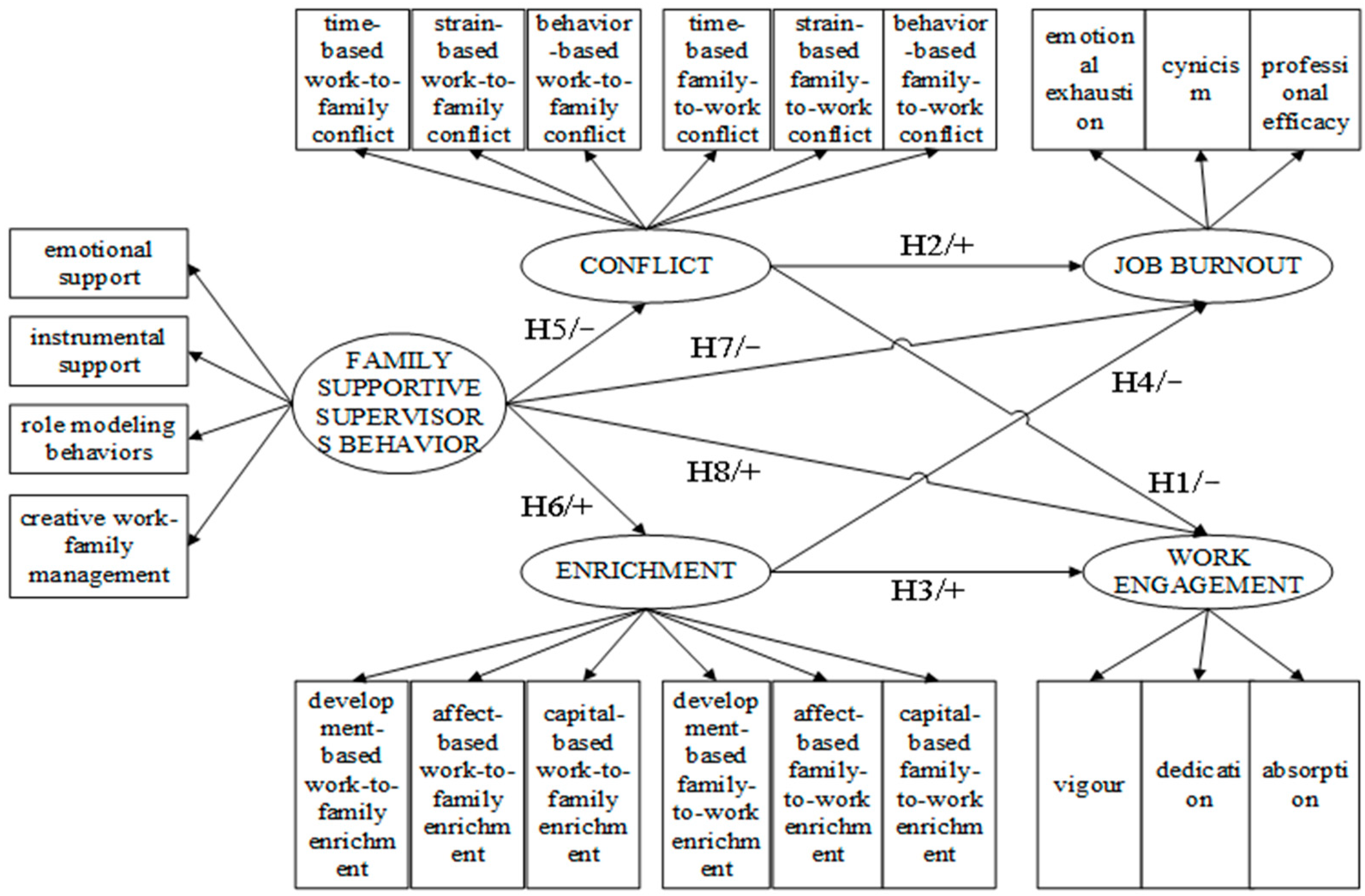
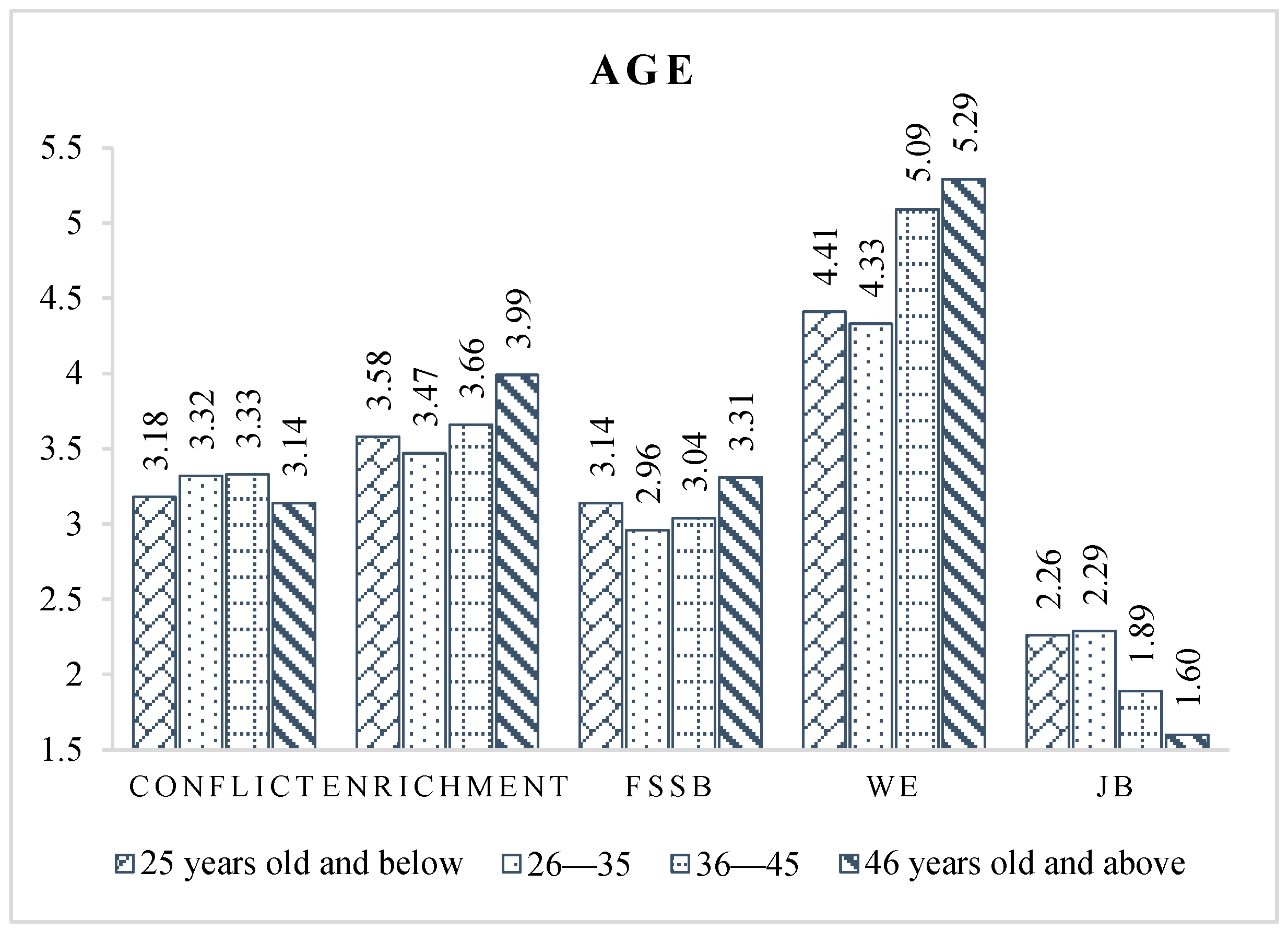
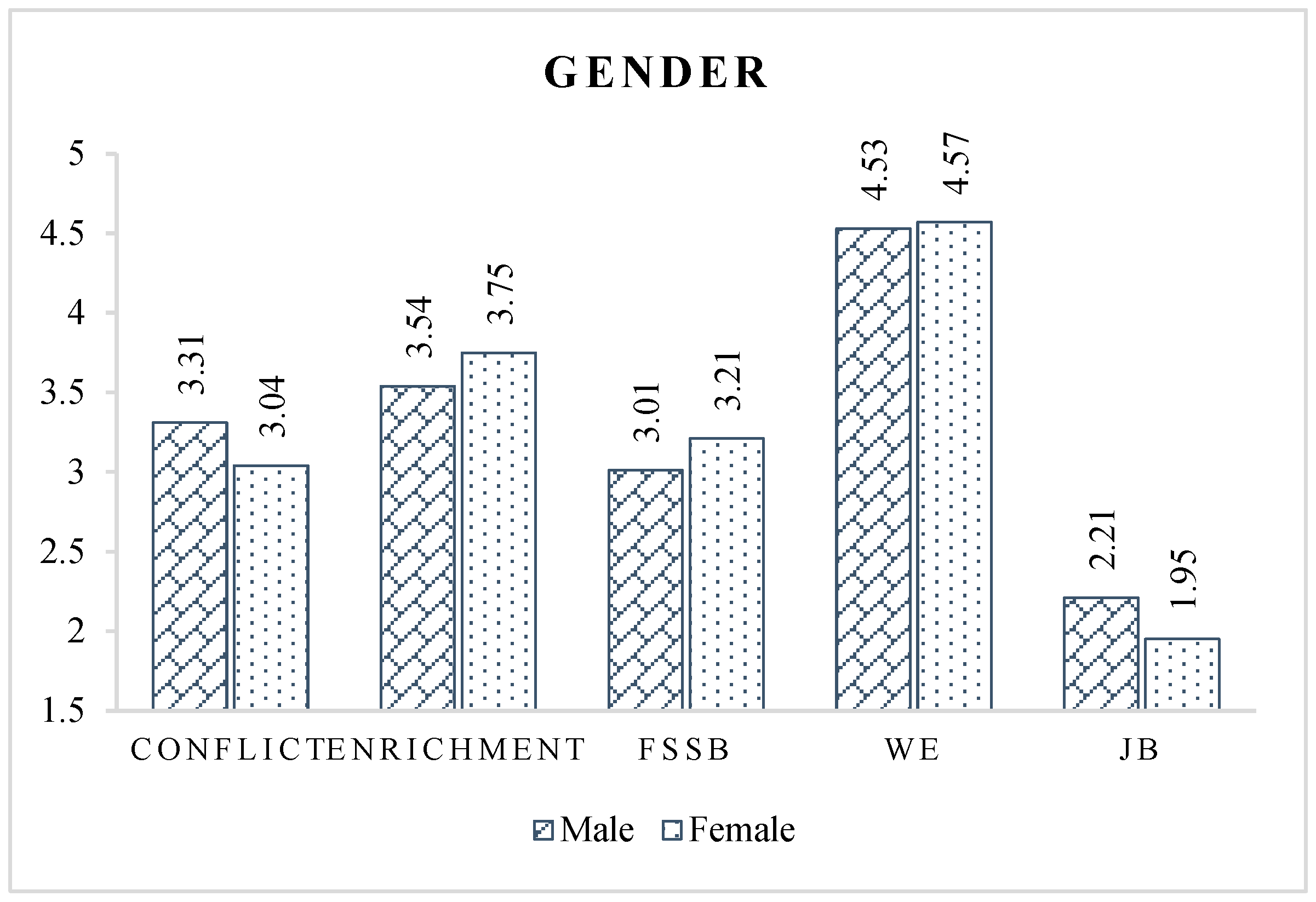

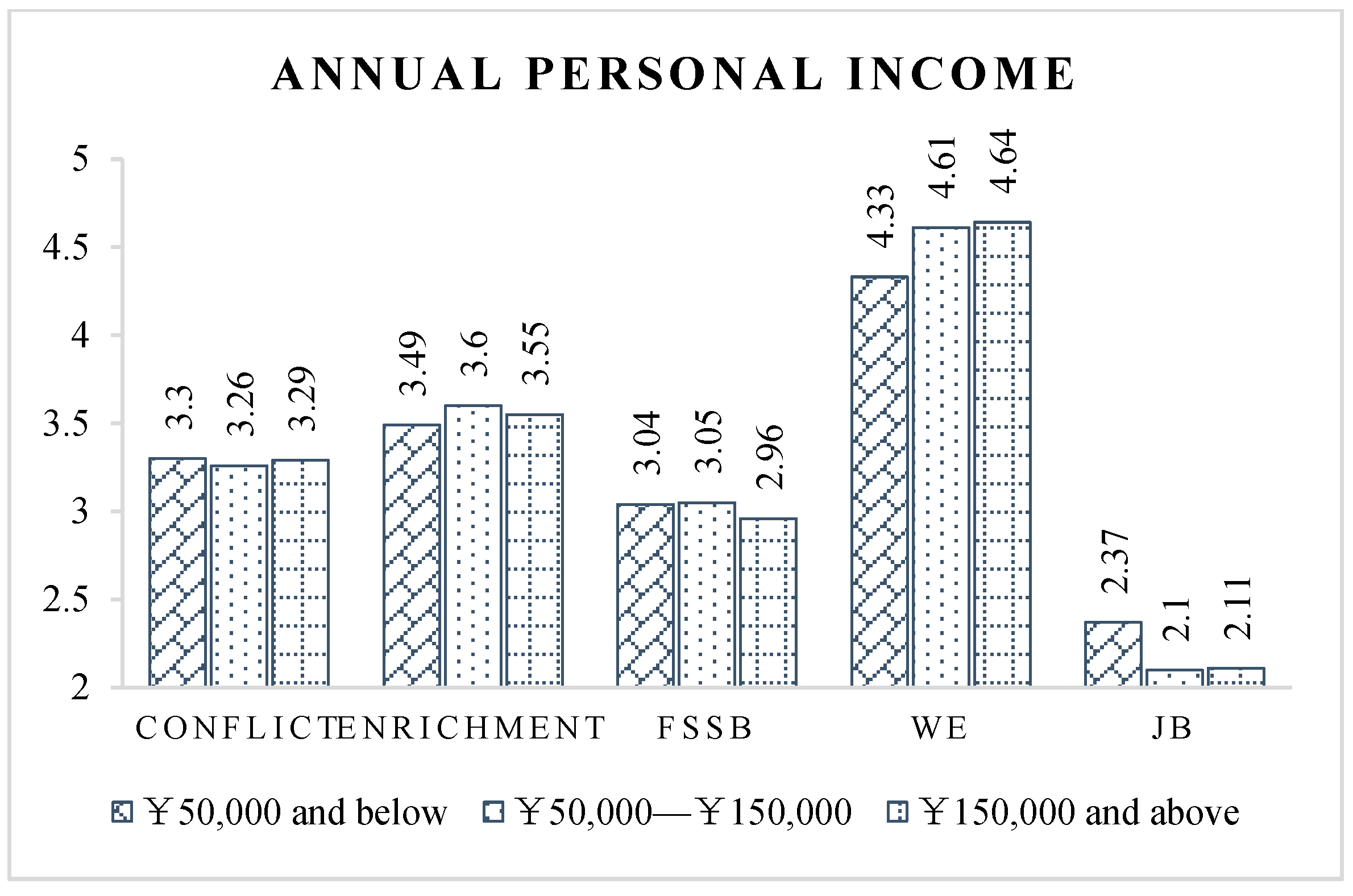
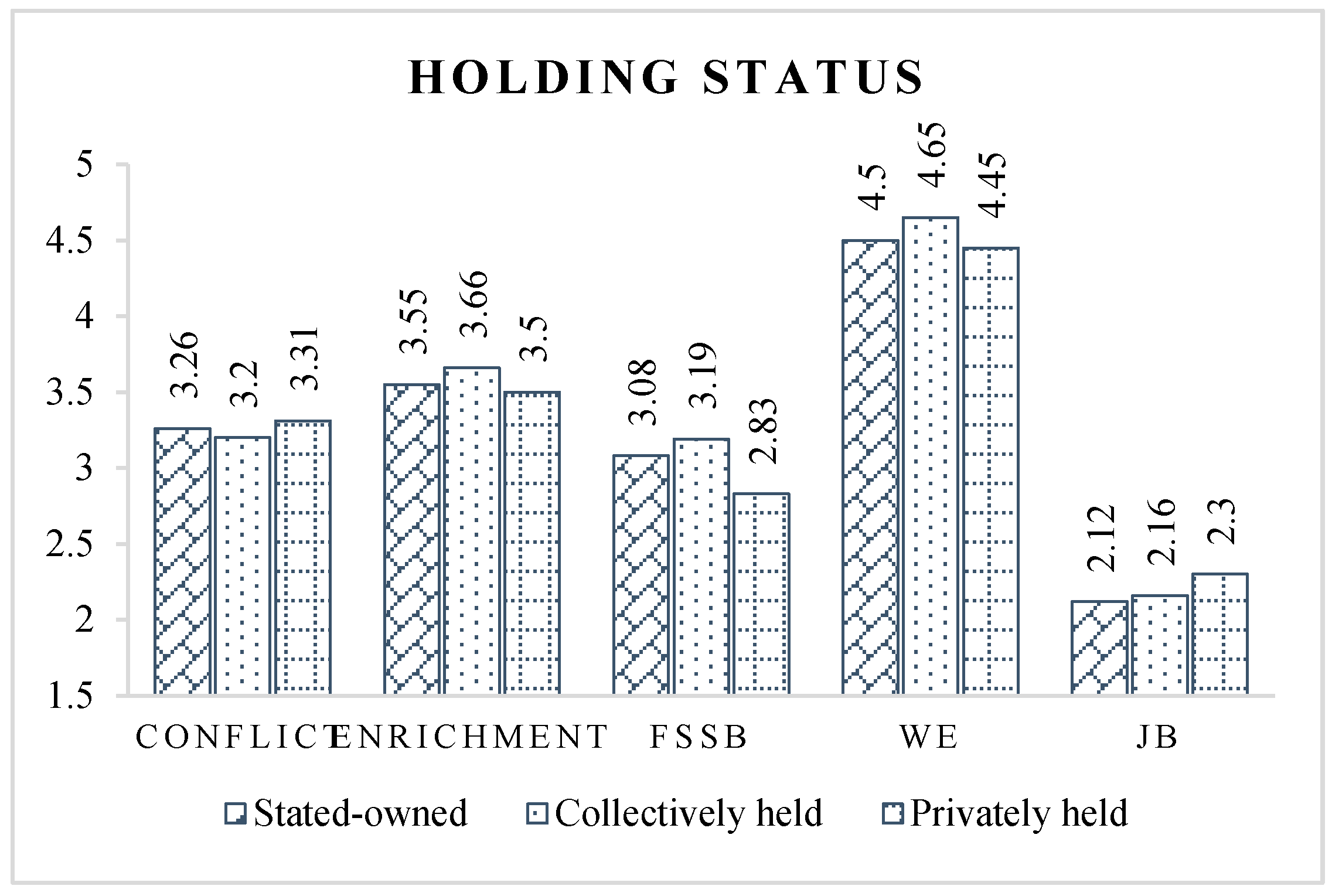
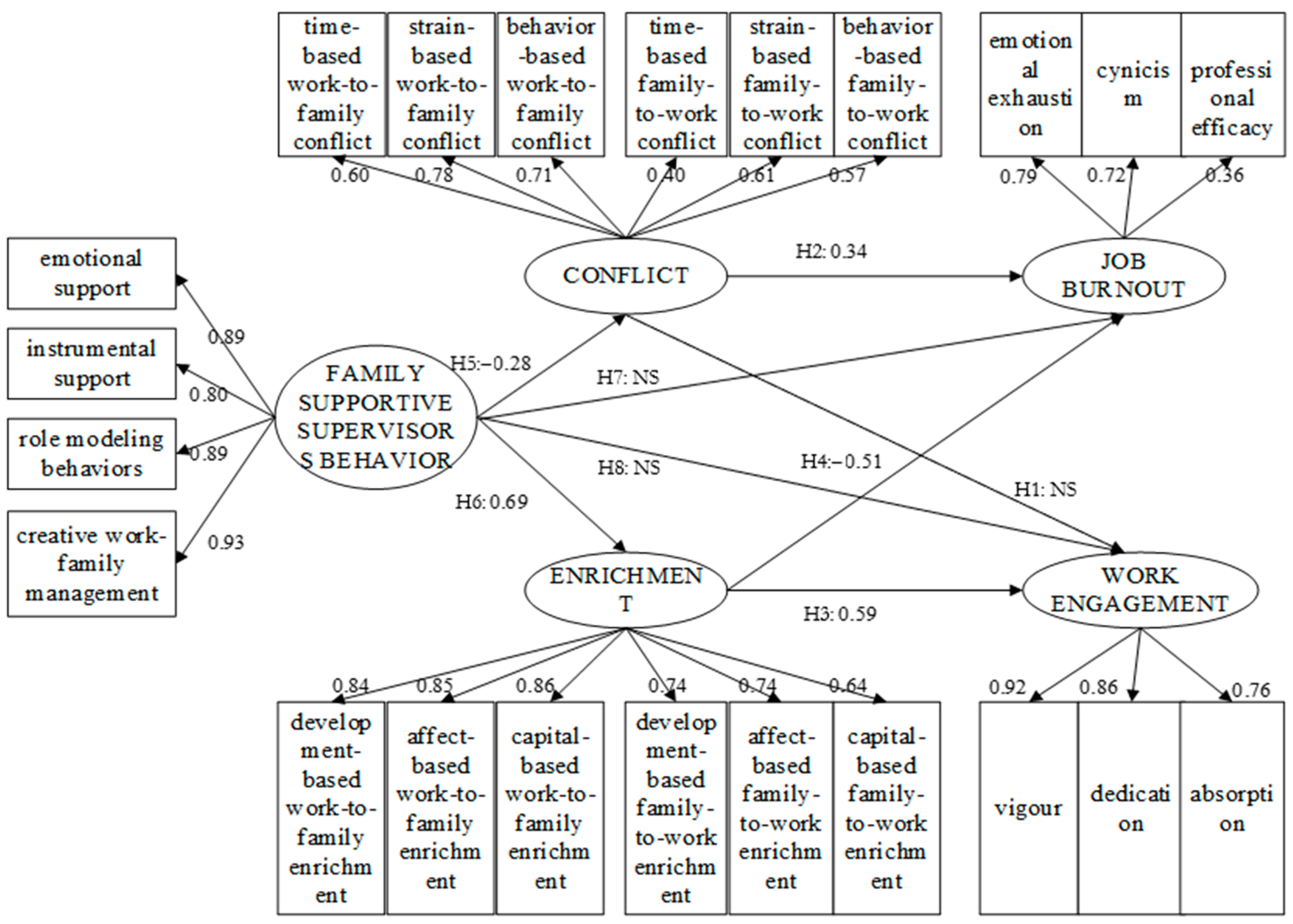
| Latent Variables | Scales | Measurement Dimensions (Observable Variables) |
|---|---|---|
| Work–family conflict (WFC) | 18-item, 5-point Likert scale [71] | Time-based work-to-family conflict (WFT) |
| Strain-based work-to-family conflict (WFS) | ||
| Behavior-based work-to-family conflict (WFB) | ||
| Time-based family-to-work conflict (FWT) | ||
| Strain-based family-to-work conflict (FWS) | ||
| Behavior-based family-to-work conflict (FWB) | ||
| Work–family enrichment (WFE) | 18-item, 5-point Likert scale [72] | Development-based work-to-family enrichment (WFD) |
| Affect-based work-to-family enrichment (WFA) | ||
| Capital-based work-to-family enrichment (WFCa) | ||
| Development-based family-to-work enrichment (FWD) | ||
| Affect-based family-to-work enrichment (FWA) | ||
| Capital-based family-to-work enrichment (FWCa) | ||
| Job burnout (JB) | MBI-GS, 16-item, 7-point Likert scale [73] | Exhaustion (EX) |
| Cynicism (CY) | ||
| Low professional efficacy (PE) | ||
| Work engagement (WE) | Short-version UWES, 9-item, 7-point Likert scale [74] | Vigor (VI) |
| Dedication (DE) | ||
| Absorption (AB) | ||
| FSSB | 14-item, 5-point Likert scale [35] | Emotional support (ES) |
| Instrumental support (IS) | ||
| Role modeling (RM) | ||
| Creative management (CM) |
| Dimensions | Group | Frequency | Proportion | Cumulative Percentage |
|---|---|---|---|---|
| Gender | Male | 390 | 87.44% | 87.44% |
| Female | 56 | 12.56% | 100.00% | |
| Age | 25 years old and below | 102 | 22.87% | 22.87% |
| 26–30 years old | 160 | 35.87% | 58.74% | |
| 31–35 years old | 87 | 19.51% | 78.25% | |
| 36–40 years old | 43 | 9.64% | 87.89% | |
| 41–45 years old | 21 | 4.71% | 92.60% | |
| 46–50 years old | 21 | 4.71% | 97.31% | |
| 51 years old and above | 12 | 2.69% | 100.00% | |
| Education level | High school and below | 34 | 7.62% | 7.62% |
| Junior college | 161 | 36.10% | 43.72% | |
| Bachelor | 245 | 54.93% | 98.65% | |
| Master | 6 | 1.35% | 100.00% | |
| Income | ¥50,000 and below | 127 | 28.48% | 28.48% |
| ¥50,000–¥150,000 | 276 | 61.88% | 90.36% | |
| ¥150,000–¥300,000 | 33 | 7.40% | 97.76% | |
| ¥300,000–¥500,000 | 8 | 1.79% | 99.55% | |
| ¥500,000 and above | 2 | 0.45% | 100.00% | |
| Position level | Project members | 284 | 63.68% | 63.68% |
| Project leaders | 162 | 36.32% | 100.00% | |
| Holdings | State-owned | 192 | 43.05% | 43.05% |
| Collective | 81 | 18.16% | 61.21% | |
| Privately held | 124 | 27.80% | 89.01% | |
| Unclear | 49 | 10.99% | 100.00% |
| Scale | Sub-Scale | Alpha of Sub-Scale | Alpha of Scale |
|---|---|---|---|
| WFC | WFT | 0.694 | 0.854 |
| WFS | 0.661 | ||
| WFB | 0.637 | ||
| FWT | 0.700 | ||
| FWS | 0.669 | ||
| FWB | 0.651 | ||
| WFE | WFD | 0.858 | 0.946 |
| WFA | 0.863 | ||
| WFCa | 0.898 | ||
| FWD | 0.835 | ||
| FWA | 0.853 | ||
| FWCa | 0.791 | ||
| FSSB | ES | 0.902 | 0.959 |
| IS | 0.829 | ||
| RM | 0.903 | ||
| CM | 0.911 | ||
| WE | VI | 0.891 | 0.925 |
| DE | 0.858 | ||
| AB | 0.818 | ||
| JB | EX | 0.875 | 0.871 |
| CY | 0.801 | ||
| PE | 0.843 |
| Scale | χ2/df | RMSEA | GFI | NNFI | CFI | AGFI | IFI |
|---|---|---|---|---|---|---|---|
| WFC | 2.785 | 0.063 | 0.921 | 0.876 | 0.903 | 0.888 | 0.904 |
| WFE | 3.453 | 0.074 | 0.896 | 0.932 | 0.947 | 0.851 | 0.947 |
| FSSB | 2.487 | 0.058 | 0.947 | 0.974 | 0.980 | 0.922 | 0.980 |
| WE | 3.948 | 0.080 | 0.956 | 0.961 | 0.974 | 0.917 | 0.974 |
| JB | 3.246 | 0.071 | 0.914 | 0.916 | 0.929 | 0.885 | 0.930 |
| Observable Variable | Items | Estimates | CR | AVE |
|---|---|---|---|---|
| WFT | WFT1 | 0.779 | 0.768 | 0.526 |
| WFT2 | 0.677 | |||
| WFT3 | 0.716 | |||
| WFS | WFS1 | 0.691 | 0.745 | 0.495 |
| WFS2 | 0.632 | |||
| WFS3 | 0.779 | |||
| WFB | WFB1 | 0.715 | 0.751 | 0.502 |
| WFB2 | 0.695 | |||
| WFB3 | 0.715 | |||
| FWT | FWT1 | 0.726 | 0.773 | 0.531 |
| FWT2 | 0.722 | |||
| FWT3 | 0.738 | |||
| FWS | FWS1 | 0.603 | 0.747 | 0.501 |
| FWS2 | 0.673 | |||
| FWS3 | 0.829 | |||
| FWB | FWB1 | 0.716 | 0.746 | 0.496 |
| FWB2 | 0.637 | |||
| FWB3 | 0.755 | |||
| WFD | WFD1 | 0.748 | 0.859 | 0.670 |
| WFD2 | 0.855 | |||
| WFD3 | 0.848 | |||
| WFA | WFA1 | 0.774 | 0.855 | 0.663 |
| WFA2 | 0.833 | |||
| WFA3 | 0.872 | |||
| WFCa | WFCa1 | 0.897 | 0.899 | 0.748 |
| WFCa2 | 0.870 | |||
| WFCa3 | 0.826 | |||
| FWD | FWD1 | 0.762 | 0.835 | 0.629 |
| FWD2 | 0.815 | |||
| FWD3 | 0.801 | |||
| FWA | FWA1 | 0.829 | 0.853 | 0.660 |
| FWA2 | 0.789 | |||
| FWA3 | 0.818 | |||
| FWCa | FWCa1 | 0.676 | 0.792 | 0.563 |
| FWCa2 | 0.688 | |||
| FWCa3 | 0.871 | |||
| ES | ES1 | 0.835 | 0.902 | 0.698 |
| ES2 | 0.855 | |||
| ES3 | 0.794 | |||
| ES4 | 0.856 | |||
| IS | IS1 | 0.736 | 0.829 | 0.620 |
| IS2 | 0.765 | |||
| IS3 | 0.853 | |||
| RM | RM1 | 0.852 | 0.900 | 0.748 |
| RM2 | 0.890 | |||
| RM3 | 0.866 | |||
| CM | CM1 | 0.825 | 0.911 | 0.720 |
| CM2 | 0.859 | |||
| CM3 | 0.832 | |||
| CM4 | 0.874 | |||
| VI | VI1 | 0.875 | 0.892 | 0.733 |
| VI2 | 0.859 | |||
| VI3 | 0.834 | |||
| DE | DE1 | 0.870 | 0.863 | 0.677 |
| DE2 | 0.801 | |||
| DE3 | 0.796 | |||
| AB | AB1 | 0.786 | 0.822 | 0.606 |
| AB2 | 0.730 | |||
| AB3 | 0.818 | |||
| EX | EX1 | 0.835 | 0.876 | 0.586 |
| EX2 | 0.682 | |||
| EX3 | 0.738 | |||
| EX4 | 0.781 | |||
| EX5 | 0.784 | |||
| CY | CY1 | 0.596 | 0.825 | 0.492 |
| CY2 | 0.526 | |||
| CY3 | 0.748 | |||
| CY4 | 0.782 | |||
| CY5 | 0.811 | |||
| PE | PE1 | 0.769 | 0.857 | 0.502 |
| PE2 | 0.697 | |||
| PE3 | 0.645 | |||
| PE4 | 0.667 | |||
| PE5 | 0.806 | |||
| PE6 | 0.652 |
| χ2/df | RMSEA | GFI | NNFI | CFI | AGFI | IFI |
|---|---|---|---|---|---|---|
| 3.325 | 0.068 | 0.907 | 0.914 | 0.922 | 0.901 | 0.923 |
Publisher’s Note: MDPI stays neutral with regard to jurisdictional claims in published maps and institutional affiliations. |
© 2022 by the authors. Licensee MDPI, Basel, Switzerland. This article is an open access article distributed under the terms and conditions of the Creative Commons Attribution (CC BY) license (https://creativecommons.org/licenses/by/4.0/).
Share and Cite
Li, X.; Wang, R.; Zhao, Y.; Yang, F.; Wang, X. An Interwoven Psychological Syndrome of Job Burnout and Work Engagement in Construction Project Management Professionals Due to Work–Family Imbalance. Int. J. Environ. Res. Public Health 2022, 19, 14111. https://doi.org/10.3390/ijerph192114111
Li X, Wang R, Zhao Y, Yang F, Wang X. An Interwoven Psychological Syndrome of Job Burnout and Work Engagement in Construction Project Management Professionals Due to Work–Family Imbalance. International Journal of Environmental Research and Public Health. 2022; 19(21):14111. https://doi.org/10.3390/ijerph192114111
Chicago/Turabian StyleLi, Xiaodong, Runshuang Wang, Yizhu Zhao, Fan Yang, and Xinyi Wang. 2022. "An Interwoven Psychological Syndrome of Job Burnout and Work Engagement in Construction Project Management Professionals Due to Work–Family Imbalance" International Journal of Environmental Research and Public Health 19, no. 21: 14111. https://doi.org/10.3390/ijerph192114111
APA StyleLi, X., Wang, R., Zhao, Y., Yang, F., & Wang, X. (2022). An Interwoven Psychological Syndrome of Job Burnout and Work Engagement in Construction Project Management Professionals Due to Work–Family Imbalance. International Journal of Environmental Research and Public Health, 19(21), 14111. https://doi.org/10.3390/ijerph192114111










